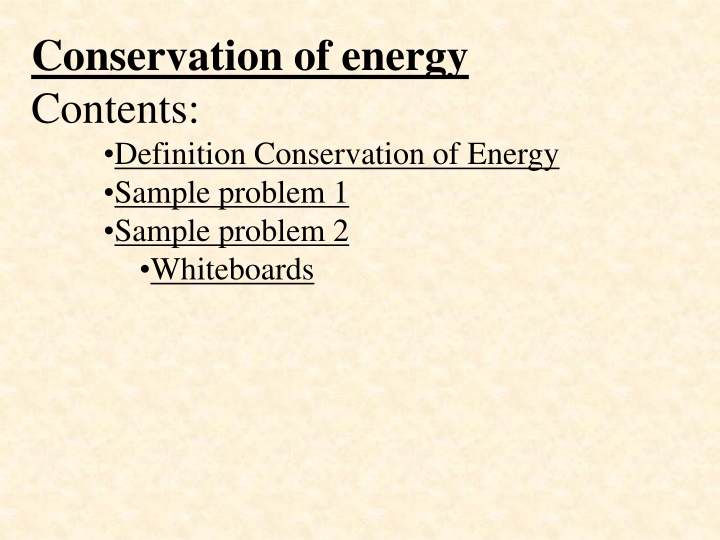
Learn About Conservation of Energy: Definitions, Examples, and Problem Solving
Explore the concept of conservation of energy, where energy is neither created nor destroyed but only transformed. Discover sample problems and whiteboard illustrations to understand how to apply this principle in physics.
Download Presentation

Please find below an Image/Link to download the presentation.
The content on the website is provided AS IS for your information and personal use only. It may not be sold, licensed, or shared on other websites without obtaining consent from the author. If you encounter any issues during the download, it is possible that the publisher has removed the file from their server.
You are allowed to download the files provided on this website for personal or commercial use, subject to the condition that they are used lawfully. All files are the property of their respective owners.
The content on the website is provided AS IS for your information and personal use only. It may not be sold, licensed, or shared on other websites without obtaining consent from the author.
E N D
Presentation Transcript
Conservation of energy Contents: Definition Conservation of Energy Sample problem 1 Sample problem 2 Whiteboards
Conservation of Energy Energy is neither created nor destroyed, it just moves around. The total energy of a closed system remains constant. Total Energy before = Total Energy After (Pendulum of death)
Conservation of Energy Total Energy before = Total Energy After Comes from = Goes to Assets = Expenditures Fd + mgh + 1/2mv2 =Fd + mgh + 1/2mv2 Speeds you up work Slows you down work
Example 1 Fd + mgh + 1/2mv2 =Fd + mgh + 1/2mv2 v = 4.5 m/s 250 kg What is its velocity at the bottom? 1.75 m 0 + (250 kg)(9.8 N/kg)(1.75 m) + 1/2(250 kg)(4.5 m/s)2 + 0 = 0 + 0 + 1/2(250 kg)v2 + 0 7.38 m/s
Example 2 Fd + mgh + 1/2mv2 =Fd + mgh + 1/2mv2 v = 6.2 m/s What is its velocity after the puddle? 890 kg 3.6 m (Puddle - Exerts 3200 N of retarding force) 1/2(890 kg)(6.2 m/s)2 =(3200 N)(3.6 m) + 1/2(890 kg)v2 3.54 m/s
Example 3 Fd + mgh + 1/2mv2 =Fd + mgh + 1/2mv2 What is its velocity after the puddle at the bottom? v = 4.5 m/s 250 kg 1.75 m Puddle exerts 1200 N of slowing force for 2.30 m 0 + (250 kg)(9.8 N/kg)(1.75 m) + 1/2(250 kg)(4.5 m/s)2 + 0 =(1200 N)(2.30 m) + 0 + 1/2(250 kg)v2 + 0 5.70 m/s
Whiteboards: Conservation of Energy 1 | 2 | 3 | 4 | 5 | 6 | 7
What speed at the bottom? vi = 0 15 kg h = 2.15 m Fd + mgh + 1/2mv2 =Fd + mgh + 1/2mv2 0 + mgh + 0 =0 + 0 + 1/2mv2 (15 kg)(9.8 N/kg)(2.15 m) = 1/2(15 kg)v2 6.5 m/s
What speed at the top? vi = 8.7 m/s 15 kg h = 2.15 m Fd + mgh + 1/2mv2 =Fd + mgh + 1/2mv2 0 + mgh + 1/2mv2 =0 + 0 + 1/2mv2 + 1/2(15 kg)(8.7 m/s)2 = (15 kg)(9.8 N/kg)(2.15 m) + 1/2(15 kg)v2 5.8 m/s
What final velocity? vi = 4.6 m/s 350 kg Pushes with 53 N for 35 m Fd + mgh + 1/2mv2 =Fd + mgh + 1/2mv2 Fd + 0 + 1/2mv2 =0 + 0 + 1/2mv2 (53 N)(35 m) + 1/2(350 kg)(4.6 m/s)2 = 1/2(350 kg)v2 5.6 m/s
What speed at the top? vi = 8.6 m/s 15 kg h = 4.25 m h = 2.15 m Fd + mgh + 1/2mv2 =Fd + mgh + 1/2mv2 0 + mgh + 1/2mv2 =0 +mgh + 1/2mv2 (15 kg)(9.8 N/kg)(2.15 m) + 1/2(15 kg)(8.6 m/s)2 =(15 kg)(9.8 N/kg)(4.25 m) 1/2(15 kg)v2 5.7 m/s
What speed at the top? vi = 7.1 m/s Accelerator exerts 48.0 N for 2.10 m 15 kg h = 2.15 m Fd + mgh + 1/2mv2 =Fd + mgh + 1/2mv2 Fd + 1/2mv2 =0 + mgh + 1/2mv2 4.66 m/s
Brakes for 4.5 m. Final speed after is 4.0 m/s. What force brakes? vi = 5.8 m/s 15 kg h = 2.15 m Fd + mgh + 1/2mv2 =Fd + mgh + 1/2mv2 0 + mgh + 1/2mv2 =Fd + 0 + 1/2mv2 (15 kg)(9.8 N/kg)(2.15 m) + 1/2(15 kg)(5.8 m/s)2 = F(4.5 m) + 1/2(15 kg)(4.0 m/s)2 99.6 N
v = 3.68 m/s 2.34 kg The hammer pushes in the nail 3.50 mm. (.00350 m). What force did it exert on the nail Fd + mgh + 1/2mv2 =Fd + mgh + 1/2mv2 0 + 0 + 1/2mv2 =Fd + 0 + 1/2(2.34 kg)(3.68 m/s)2 = F(.0035 m) 0 4530 N
The 125 kg pile driver drives the piling in .25 m with one stroke. What force does it exert? (careful what you use as the change in height) 3.2 m Fd + mgh + 1/2mv2 =Fd + mgh + 1/2mv2 0 + mgh + 0=Fd + 0 + (125 kg)(9.8 N/kg)(3.2 m + .25 m) = F(.25 m) 0 17,000 N
